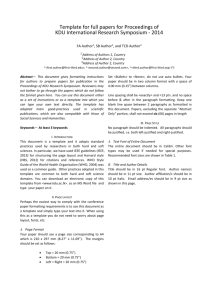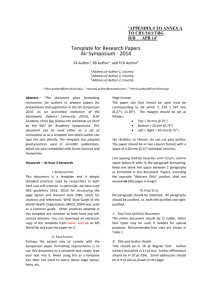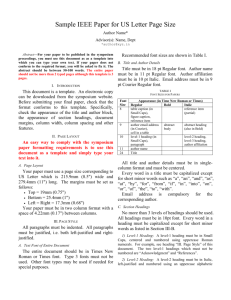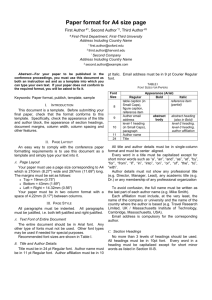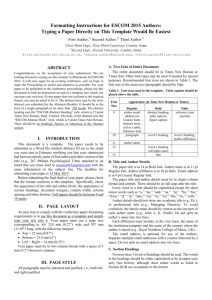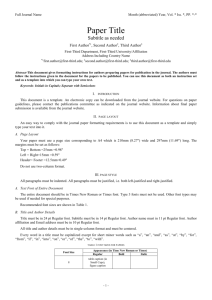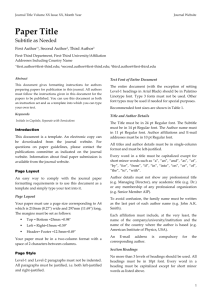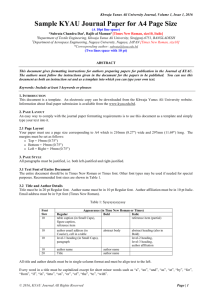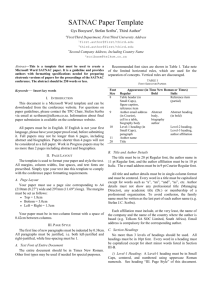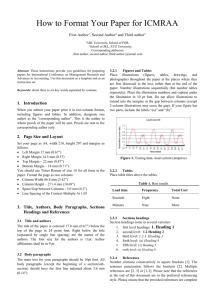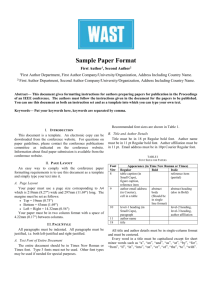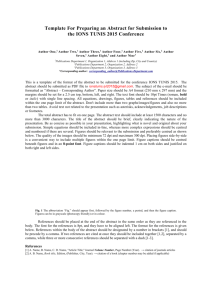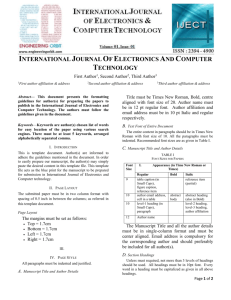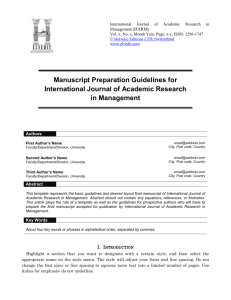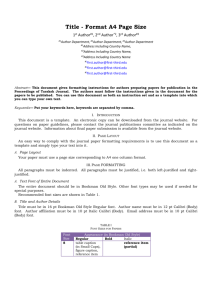Guidelines and template for full papers
advertisement
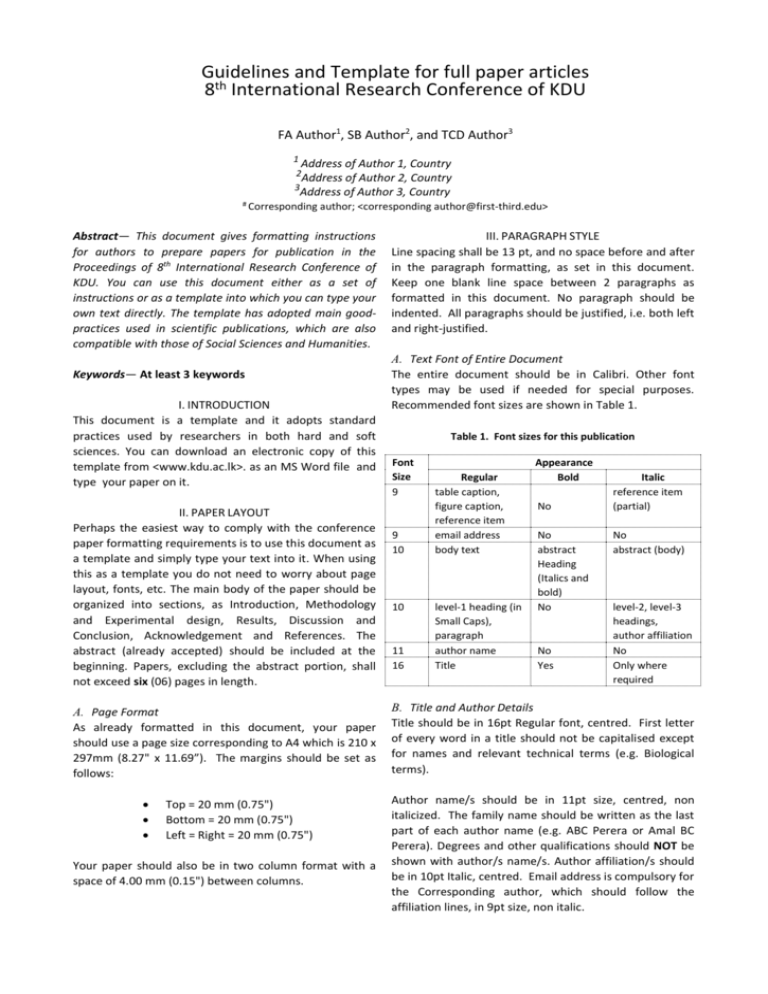
Guidelines and Template for full paper articles 8th International Research Conference of KDU FA Author1, SB Author2, and TCD Author3 1 Address of Author 1, Country 2Address of Author 2, Country 3Address of Author 3, Country # Corresponding author; <corresponding author@first-third.edu> Abstract— This document gives formatting instructions for authors to prepare papers for publication in the Proceedings of 8th International Research Conference of KDU. You can use this document either as a set of instructions or as a template into which you can type your own text directly. The template has adopted main goodpractices used in scientific publications, which are also compatible with those of Social Sciences and Humanities. Keywords— At least 3 keywords I. INTRODUCTION This document is a template and it adopts standard practices used by researchers in both hard and soft sciences. You can download an electronic copy of this template from <www.kdu.ac.lk>. as an MS Word file and type your paper on it. II. PAPER LAYOUT Perhaps the easiest way to comply with the conference paper formatting requirements is to use this document as a template and simply type your text into it. When using this as a template you do not need to worry about page layout, fonts, etc. The main body of the paper should be organized into sections, as Introduction, Methodology and Experimental design, Results, Discussion and Conclusion, Acknowledgement and References. The abstract (already accepted) should be included at the beginning. Papers, excluding the abstract portion, shall not exceed six (06) pages in length. A. Page Format As already formatted in this document, your paper should use a page size corresponding to A4 which is 210 x 297mm (8.27" x 11.69”). The margins should be set as follows: Top = 20 mm (0.75") Bottom = 20 mm (0.75") Left = Right = 20 mm (0.75") Your paper should also be in two column format with a space of 4.00 mm (0.15") between columns. III. PARAGRAPH STYLE Line spacing shall be 13 pt, and no space before and after in the paragraph formatting, as set in this document. Keep one blank line space between 2 paragraphs as formatted in this document. No paragraph should be indented. All paragraphs should be justified, i.e. both left and right-justified. A. Text Font of Entire Document The entire document should be in Calibri. Other font types may be used if needed for special purposes. Recommended font sizes are shown in Table 1. Table 1. Font sizes for this publication Font Size 9 9 10 10 11 16 Regular table caption, figure caption, reference item email address body text level-1 heading (in Small Caps), paragraph author name Title Appearance Bold No No abstract Heading (Italics and bold) No No Yes Italic reference item (partial) No abstract (body) level-2, level-3 headings, author affiliation No Only where required B. Title and Author Details Title should be in 16pt Regular font, centred. First letter of every word in a title should not be capitalised except for names and relevant technical terms (e.g. Biological terms). Author name/s should be in 11pt size, centred, non italicized. The family name should be written as the last part of each author name (e.g. ABC Perera or Amal BC Perera). Degrees and other qualifications should NOT be shown with author/s name/s. Author affiliation/s should be in 10pt Italic, centred. Email address is compulsory for the Corresponding author, which should follow the affiliation lines, in 9pt size, non italic. C. Section Headings No more than 3 levels of section headings should be used. All headings should be in 10pt font. Level-1 headings should be used for categorizing different sections of the main body. Each section can be additionally categorized using Level-2 and Level-3 headings. 1) Level-1 Heading: They should be in Uppercase, centred. The level-1 heading carries a number in Roman uppercase except for headings “ACKNOWLEDGMENT” and “REFERENCES”. For example, see headings “I. INTRODUCTION” and “Acknowledgement” of this document. 2) Level-2 Heading: This heading should be in Italic, leftjustified and numbered using an uppercase alphabetic letter followed by a period. For example, see heading “C. Section Headings” above. 3) Level-3 Heading: This heading should be left-justified in italic and numbered with an Arabic numeral followed by a right parenthesis. The level-3 heading should end with a colon. The body of the level-3 section immediately follows the level-3 heading in the same paragraph. For example, this paragraph begins with a level-3 heading. D. Figures and Tables Figures and Tables should be centred in the column. Large Figures and Tables may span across both columns. Any Table or Figure that takes up more than 1 column width should be positioned either at the top or at the bottom of the page. When you include images, make sure that the resolution is adequate to reveal the important detail in the Figure. Please check all Figures in your paper both on screen and on a black-and-white hardcopy. E. Figure and Table Captions Always start the word Table or Figure/Fig with an uppercase letter as shown in this page. Figures and Tables should be separately numbered using Arabic numerals. Captions should be in 9pt Regular font. Captions of a single line (e.g. Fig 1) should be centred whereas multi-line captions should be justified. Captions with Figure numbers should be placed after their associated Figures, as shown in Fig 1. Captions with Table numbers should be placed as shown in Table 1. F. Page Numbers, Headers and Footers Page numbers, headers and footers should NOT be used. G. Links and Bookmarks If you need to refer to an Internet, email address or URL in your paper, you should type out the address or URL fully in Regular font within <…> marks. H. Units and Symbols SI system should be followed. Leave a one letter space between the numerical figure/value and the symbol of the unit as shown in the above statement. I. References The list of the References should not be numbered. Arrange the list of references in alphabetical order of the family name/surname of the first author. All reference items should be in 9pt font. Please use “Harvard style” referencing with formatting as in the example given below. Names of only up to 3 authors should be included. Zhang S, Zhu C, Sin JKO, et al (1999) A novel ultrathin elevated channel low-temperature poly-Si TFT, IEEE Electron Device Lett., 20, 569–571. J. Abbreviations and specific symbols When any abbreviation occurs for the first time in a paper, it should be given in full words followed by the abbreviation within parenthesis. Specific symbols also should be treated in the same manner. Figure 1. A line graph using colours Graphics may be in full color. All colors will be retained on the PDF. Graphics should not use stipple fill patterns because they may not be reproduced properly. Please use only SOLID FILL colors which contrast well both on screen and on a black-and-white hardcopy, as shown in Fig 1. ACKNOWLEDGMENT The heading of the Acknowledgment section and the References section should not be numbered. Please do not acknowledge persons by their posts/positions. You may acknowledge funding organizations, research institutes and those who have supported your research work.
